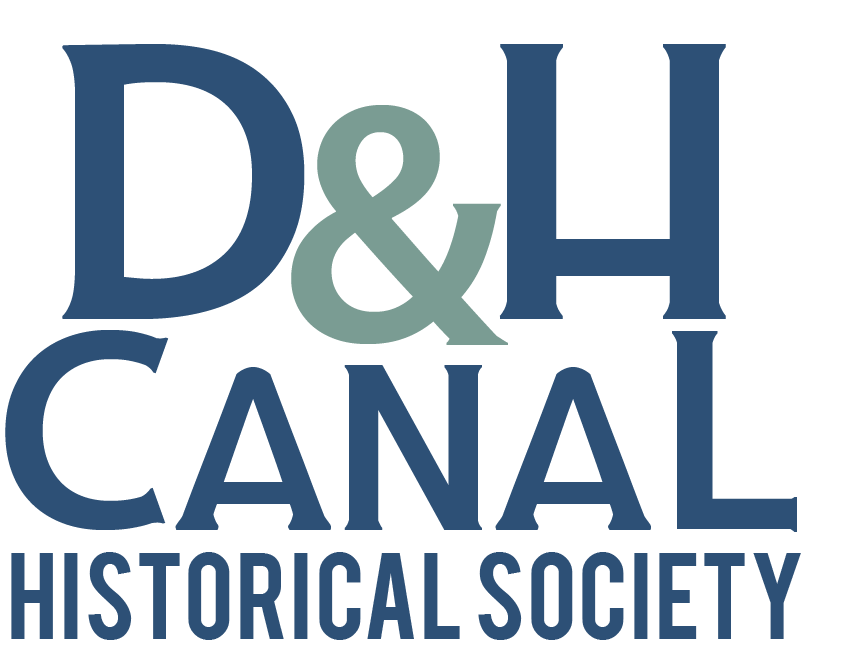D&H Canal Boat Models
Curator’s Corner
The D&H Canal Historical Society, like most museums, can only display a fraction of the material in its collections. Among items currently not on display are a number of wonderful canal boat models, ranging from folk art depictions to ones conceived of as reduced-sized replicas of the boats that plied the D&H Canal’s waters in the 19th and early 20th centuries. They make a great topic for this electronic issue of our Canawler newsletter, as space here is not as limited as it is in printed ones, allowing me to focus on multiple items, rather than a single one.
This small folk art boat shown below is a recent donation, possibly made as a toy for some lucky child. It bears little resemblance to the actual D&H Canal boats, yet is clearly a canal boat. Presumably there was a figure of the captain in the hole on the stern-end cabin. Though inaccurate, it is quite whimsical.
We have no idea if it was inspired by the D&H Canal but it was purchased by the donor at a local flea market, so it is quite possible that it was. It measures 14” by 5”.
Prisoner-made items are fairly common and generally considered folk art. The model of a section boat shown to the left was made by a prisoner and subsequently purchased at a Pennsylvania auction of canal items.
Section boats were required on the Morris Canal, necessary for use on its inclined planes, which were a way to overcome changes in elevation where locks were impractical. On an inclined plane, the canal boat was floated onto a pair of rail cars and its two sections disconnected. The sections were then pulled up an incline out of the water to a higher level (or down to a lower level) to be reconnected and returned to the water, to continue its journey. Inclined planes used little if any water and could ascend greater elevations. Though constructed for the Morris Canal, section boats were necessary on any canal that connected to it, and were also used on other canals, as they were about 75% cheaper than a single-hulled canal boat, while still able to carry the same weight of cargo. As a result, they were common on the D&H Canal.
Furthermore, some canawlers started the season on the Morris Canal, which is further south than the D&H Canal so opened earlier each spring. When the D&H opened a few weeks later, many boat captains switched to it for the greater recompense. This model measures 34” by 4”, probably a bit too long to be considered a replica, although it is otherwise a very accurate depiction.
The boat model pictured above was on display at our old D&H Canal Museum. It was made by Nicholas Bruck circa 1875-80. The interpretive sign for it states “Nicholas Bruck, born in 1864, the eldest son of Nicholas Bruck Sr. of Kingston, worked on his father’s canal boat from the time he was old enough to be of help. He made this model, which still has its original paint….” It is quite large and falls under the category of folk art, a facsimile, as its proportions are all wrong- it is much wider in relation to its length as compared to the real thing. (The D&H Canal boats were originally 70’ by 9 ½’ and later 90’ by 14 ½’, after the final enlargement of 1850. So both the smaller, pre-1850 boats and the larger ones used after that time were much longer and narrower than this model.) It measures 38” by 10”.
Dubois Weber Model
This next boat was built as a replica - it conforms more closely to the original proportions of the post-1850 boats. The model’s maker, Dubois Weber, operated a boat on the D&H Canal in its final years. This model measures 48” by 8”. It, too, was on display at our old museum.
Weber was one of a number of canawlers still alive in the second half of the 20th century, when interest in the D&H Canal and Gravity Railroad inspired many excellent secondary source histories. The oral histories that we have collected from people like Mr. Weber add tremendously to our understanding of the D&H Canal.
Finally, the diorama shown below was a collaboration between our museum and the Den of Marbletown, a local Steiff figure museum and store. They made a large print of an historic image of the D&H Canal from our extensive photograph collection for the background and we initially lent them the section boat model before we accessioned it.
The diorama was slated to be lent to us after a year on display at the Den, but proved so popular that, after ten years, I offered to make a new boat to replace the section boat model, as we wanted it to be accessioned into our collections. This model was built to be as accurate as possible, using historic measurements and images as a guide. That is the boat in the photograph. It is populated with many Steiff figures, including an alligator. The bear at the bow-end of the boat is depicted reading the New York Times article below.
Be sure to go and see it after your visit to our Museum!
These many boat models attest to how the romance of life on the Delaware and Hudson Canal inspired many people to celebrate it in its time, and to this day, by constructing canal boat models.
Bill Merchant
Deputy Director for Collections, Historian & Curator







